Polymethyl methacrylate (PMMA) offers superior optical clarity, UV resistance, and weather durability compared to polyethylene, making it ideal for high-quality, outdoor signage. Polyethylene is more cost-effective and impact-resistant but lacks the transparency and long-term weather stability required for premium signage applications.
Table of Comparison
| Property | Polymethyl Methacrylate (PMMA) | Polyethylene (PE) |
|---|---|---|
| Material Type | Thermoplastic acrylic | Thermoplastic polymer |
| Transparency | High clarity, optically transparent | Opaque to translucent |
| Weather Resistance | Excellent UV resistance, resists yellowing | Good UV resistance but can degrade over time |
| Impact Strength | Moderate, more brittle | High impact resistance, flexible |
| Weight | Lightweight | Very lightweight |
| Ease of Fabrication | Easy to cut, drill, and thermoform | Easy to mold, less suitable for detailed machining |
| Cost | Moderate to high | Low to moderate |
| Common Signage Uses | Clear signage, backlit displays, decorative elements | Outdoor signs, protective coverings, flexible banners |
Introduction to Signage Materials
Polymethyl methacrylate (PMMA) and polyethylene (PE) are widely used materials in the signage industry due to their unique properties. PMMA, known for its clarity, UV resistance, and rigidity, offers excellent optical transparency making it ideal for illuminated and high-visibility signs. Polyethylene is valued for its durability, flexibility, and cost-effectiveness, making it suitable for outdoor signage that requires impact resistance and weatherability.
Overview of Polymethyl Methacrylate (PMMA)
Polymethyl methacrylate (PMMA) is a transparent thermoplastic commonly known as acrylic or plexiglass, widely used in signage for its excellent optical clarity, weather resistance, and UV stability. Unlike polyethylene, PMMA offers superior rigidity and scratch resistance, making it ideal for outdoor and high-visibility applications. Its ability to be easily fabricated and polished enhances the quality and durability of signage displays.
Overview of Polyethylene for Signage
Polyethylene for signage offers exceptional flexibility and durability, making it ideal for outdoor applications requiring resistance to impact and weathering. Its low cost and ease of fabrication enable large-scale production of signs with varying thicknesses and sizes, while its chemical resistance ensures long-lasting vibrancy of printed graphics. Compared to polymethyl methacrylate, polyethylene provides superior toughness and is less prone to cracking under stress, enhancing its utility in dynamic environments.
Key Physical Properties Compared
Polymethyl methacrylate (PMMA) offers superior optical clarity with light transmittance up to 92%, making it ideal for high-visibility signage, whereas polyethylene (PE) typically provides lower clarity but excels in impact resistance and flexibility. PMMA features a higher tensile strength of around 70 MPa compared to polyethylene's 15-30 MPa, contributing to better structural integrity in rigid displays. Temperature resistance for PMMA ranges from -40degC to 90degC, outperforming polyethylene's lower melting point near 115degC, which limits PE in high-heat environments but provides enhanced chemical resistance and moisture barrier properties.
Durability and Weather Resistance
Polymethyl methacrylate (PMMA) offers superior weather resistance and UV stability compared to polyethylene, making it ideal for outdoor signage exposed to prolonged sunlight and harsh weather conditions. PMMA maintains clarity and structural integrity without yellowing or becoming brittle over time, whereas polyethylene tends to degrade and lose shape under extended UV exposure. The enhanced durability of PMMA ensures longer-lasting signage performance with minimal maintenance in diverse environmental conditions.
Clarity and Aesthetic Appeal
Polymethyl methacrylate (PMMA) offers superior clarity with light transmittance around 92%, making it ideal for high-visibility signage requiring crisp, vibrant displays. Compared to polyethylene, PMMA exhibits greater resistance to yellowing and weathering, preserving aesthetic appeal over time in outdoor environments. Its smooth, glossy finish enhances color brilliance and detail sharpness, outperforming the often more opaque and less visually striking polyethylene options.
Ease of Fabrication and Installation
Polymethyl methacrylate (PMMA) offers superior ease of fabrication for signage due to its excellent clarity, versatility in thermoforming, and ability to be precisely laser cut or engraved, making it ideal for detailed and custom designs. Polyethylene, while more cost-effective and impact-resistant, is less suitable for intricate fabrication because it has a lower melting point and limited ability to hold fine detail, which can complicate cutting and shaping processes. Installation of PMMA signage is typically easier and faster, as it provides a rigid, smooth finish that allows for straightforward mounting with adhesives or fasteners, whereas polyethylene's flexibility may require additional support structures and careful handling to prevent deformation.
Cost and Budget Considerations
Polymethyl methacrylate (PMMA) typically exhibits higher material costs compared to polyethylene, impacting the initial budget allocation for signage projects. While PMMA offers superior clarity and weather resistance, polyethylene provides a more cost-effective solution with flexibility and durability at a lower price point. Budget-conscious signage applications often prioritize polyethylene for large-scale or temporary displays due to its affordability and ease of fabrication.
Environmental Impact and Recycling
Polymethyl methacrylate (PMMA) offers superior clarity and UV resistance for signage but poses recycling challenges due to its thermoset structure and limited recycling facilities, often resulting in landfill accumulation. Polyethylene (PE), particularly high-density polyethylene (HDPE), provides easier recyclability and lower environmental footprint from production to disposal, making it a preferable choice for eco-conscious signage solutions. Both materials' life cycle assessments emphasize PE's advantage in circular economy models, while PMMA requires improved recycling technologies to mitigate environmental impact.
Choosing the Right Material for Your Signage
Polymethyl methacrylate (PMMA) offers superior clarity, UV resistance, and weather durability, making it ideal for outdoor and high-visibility signage. Polyethylene (PE), known for its impact resistance and cost-effectiveness, suits temporary or indoor signage where flexibility is prioritized. Selecting the right material depends on factors such as exposure to sunlight, budget constraints, and desired longevity of the signage.

Infographic: Polymethyl methacrylate vs Polyethylene for Signage
 azmater.com
azmater.com